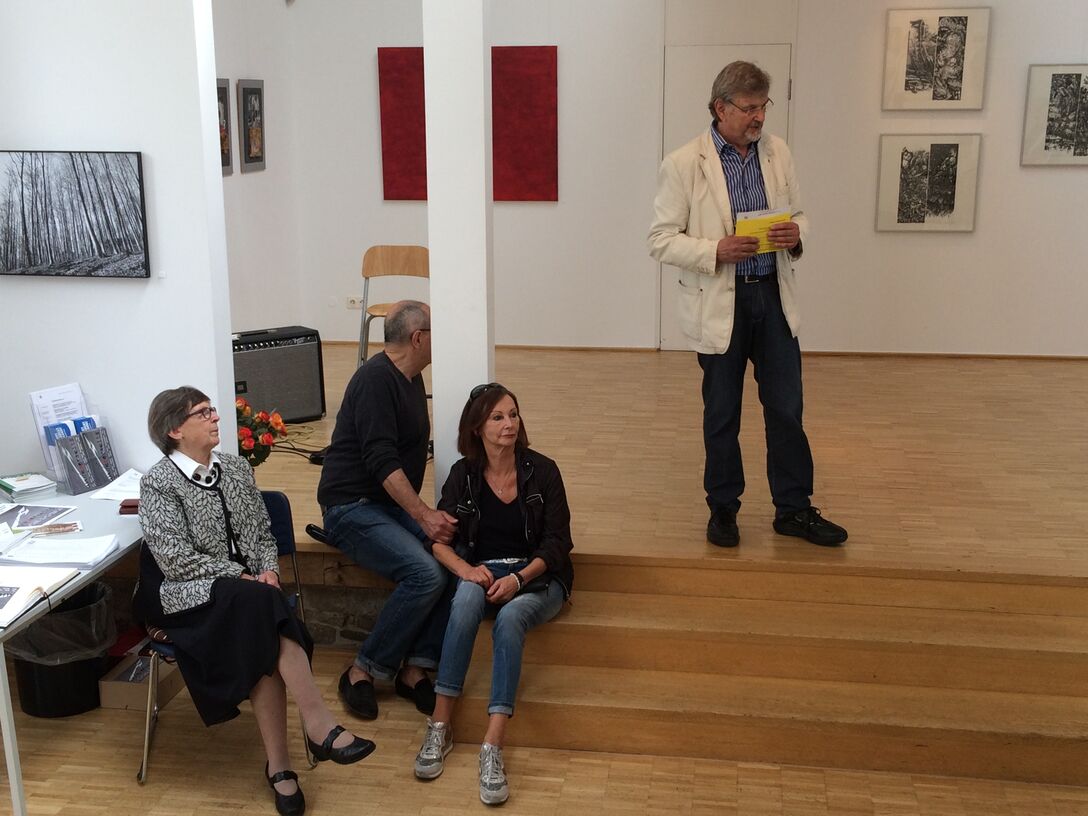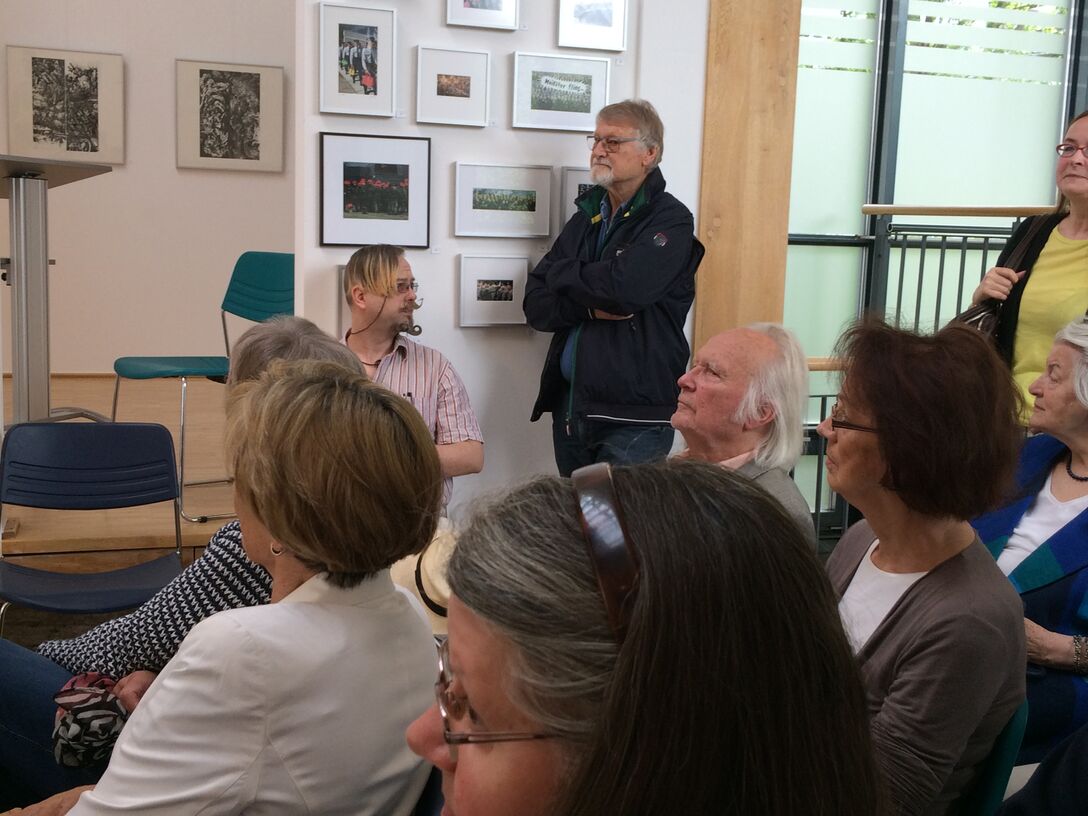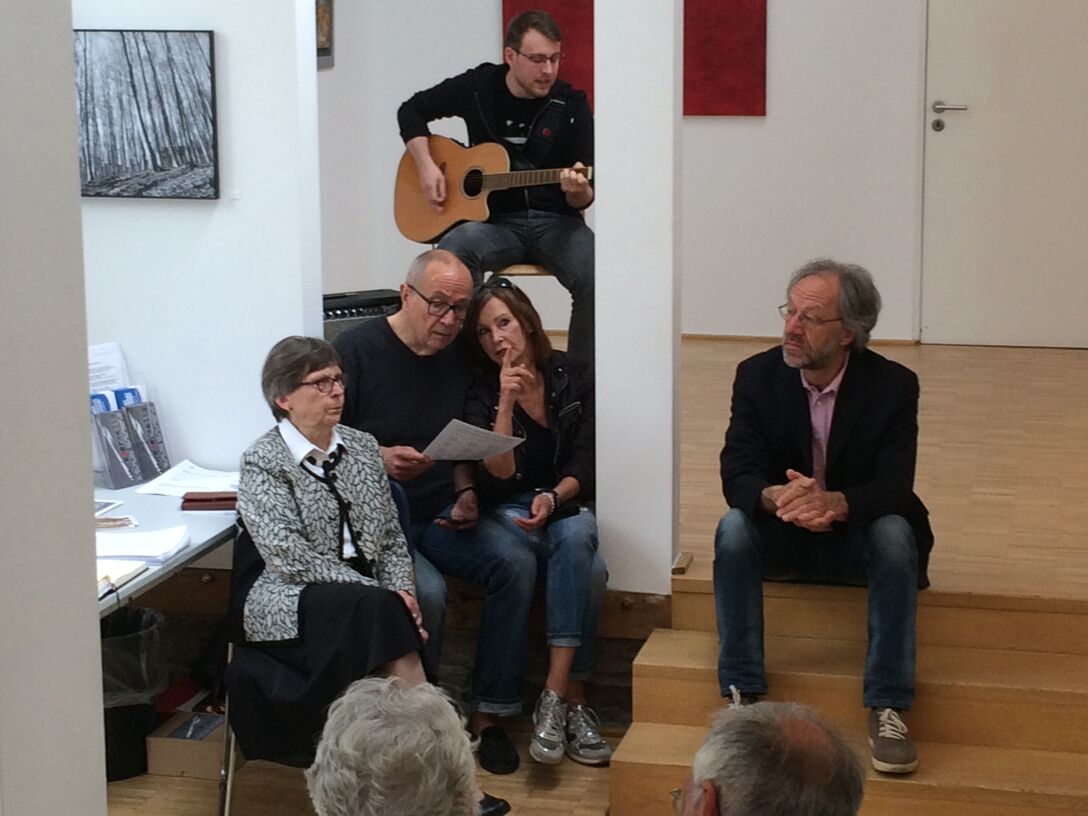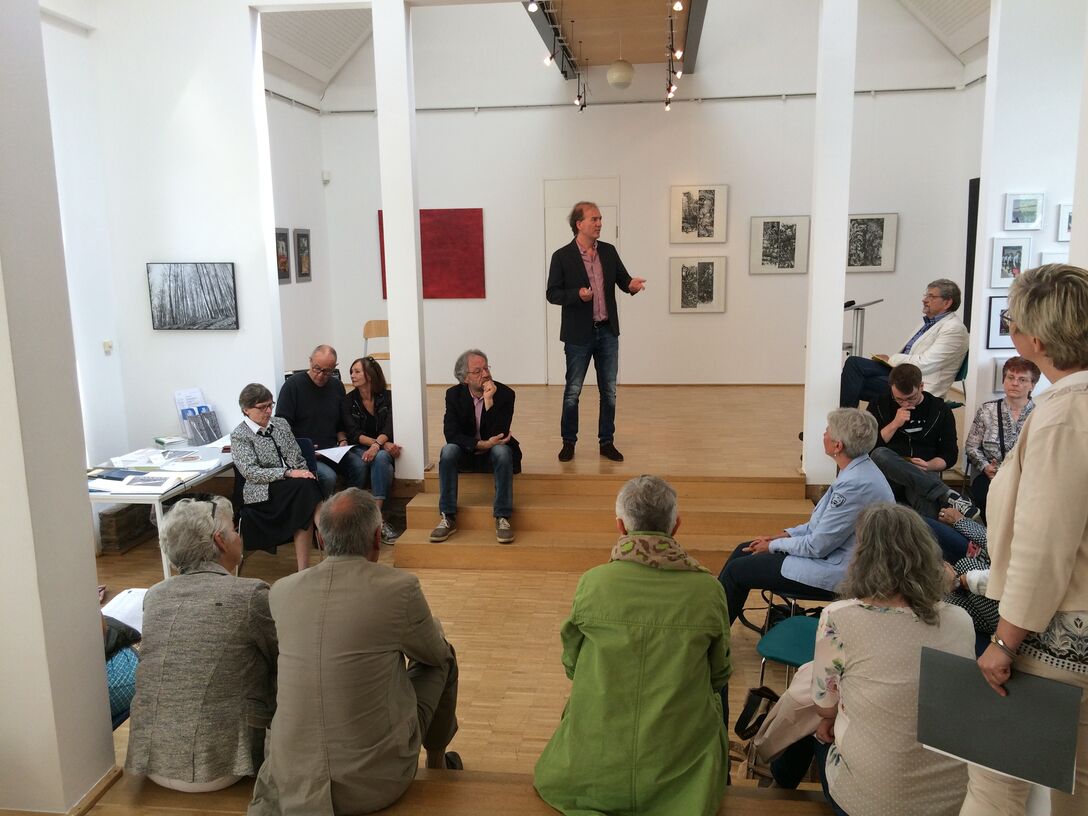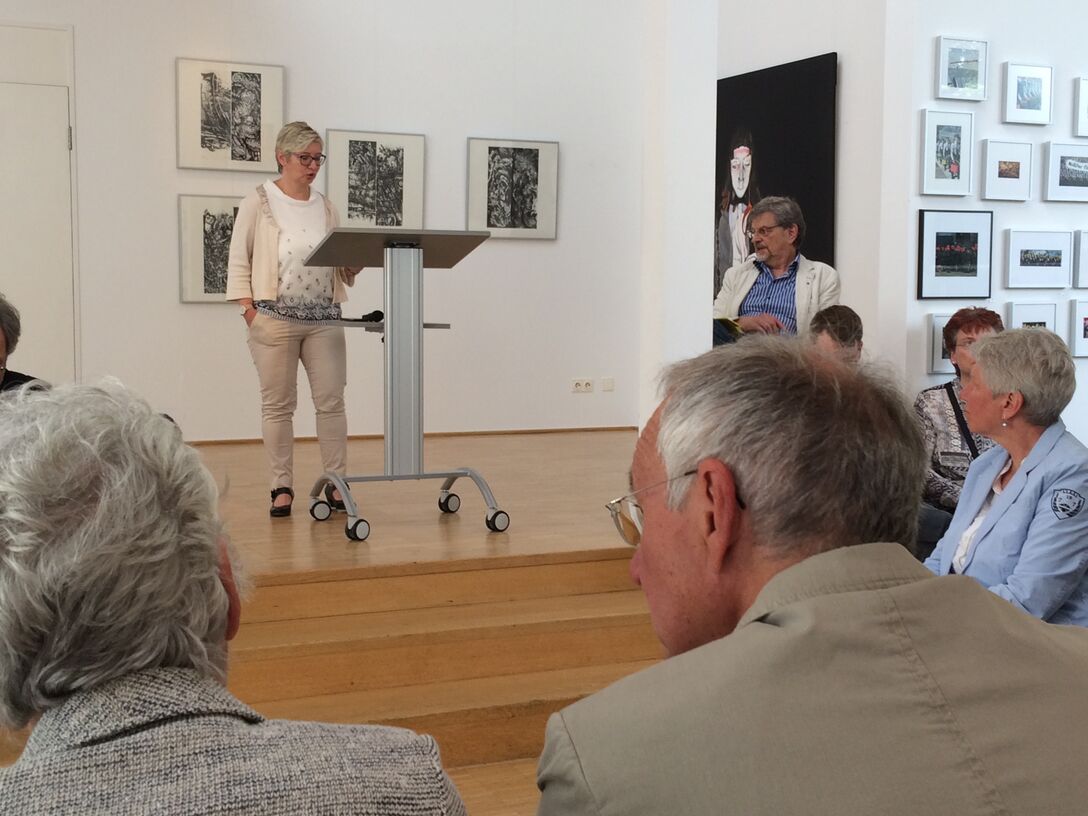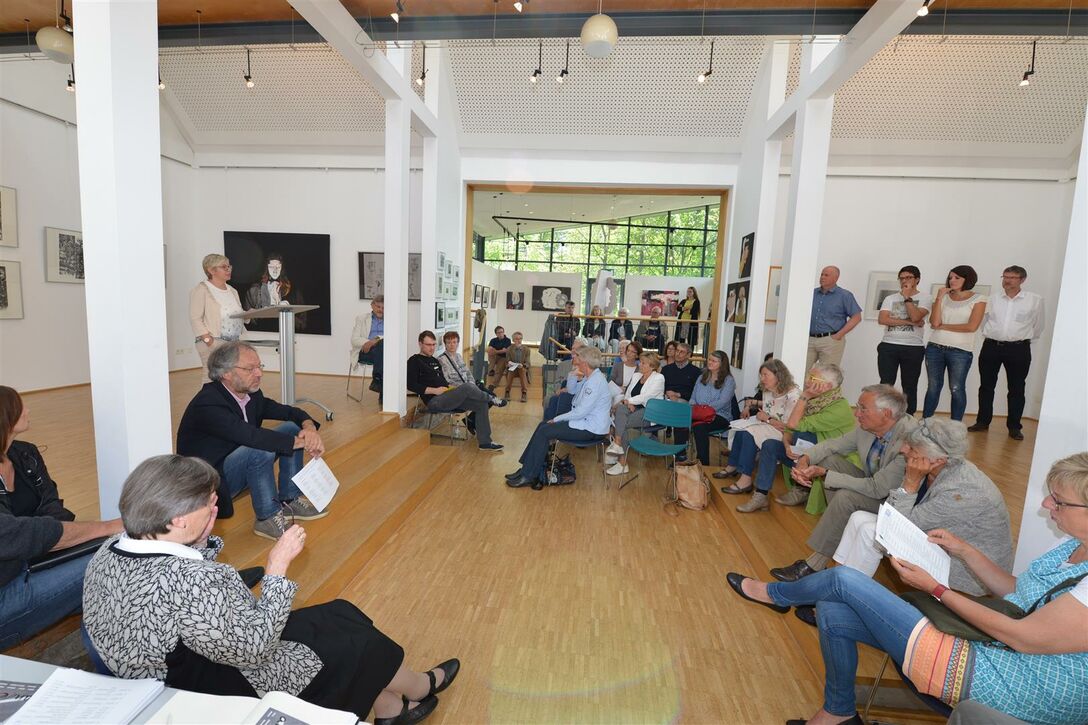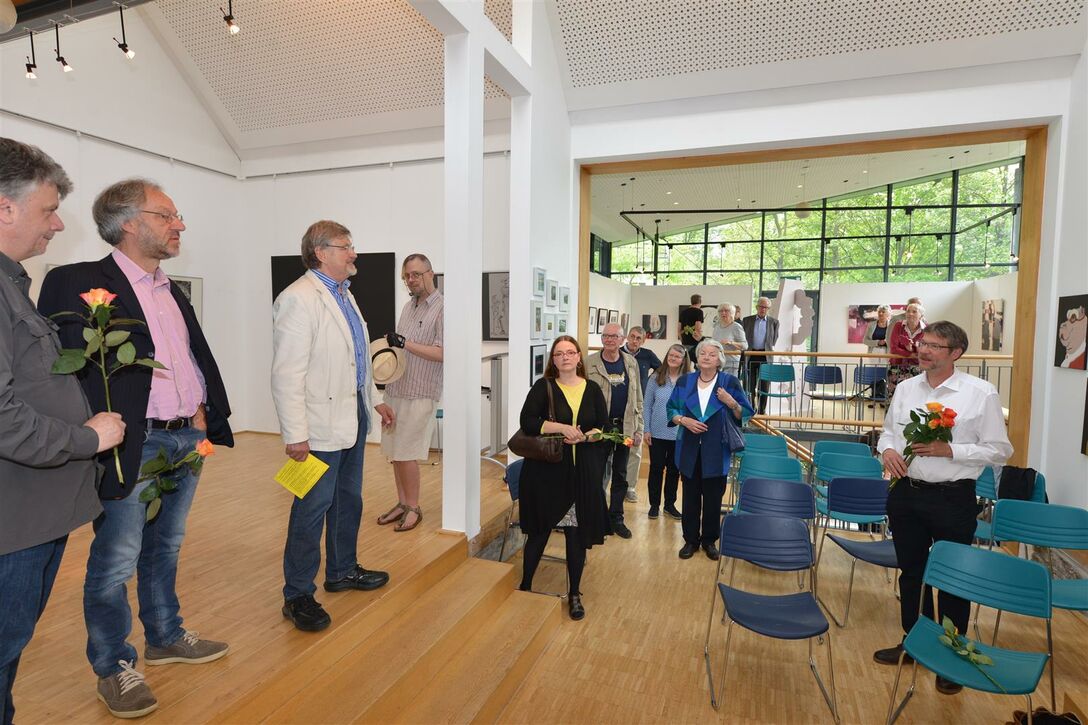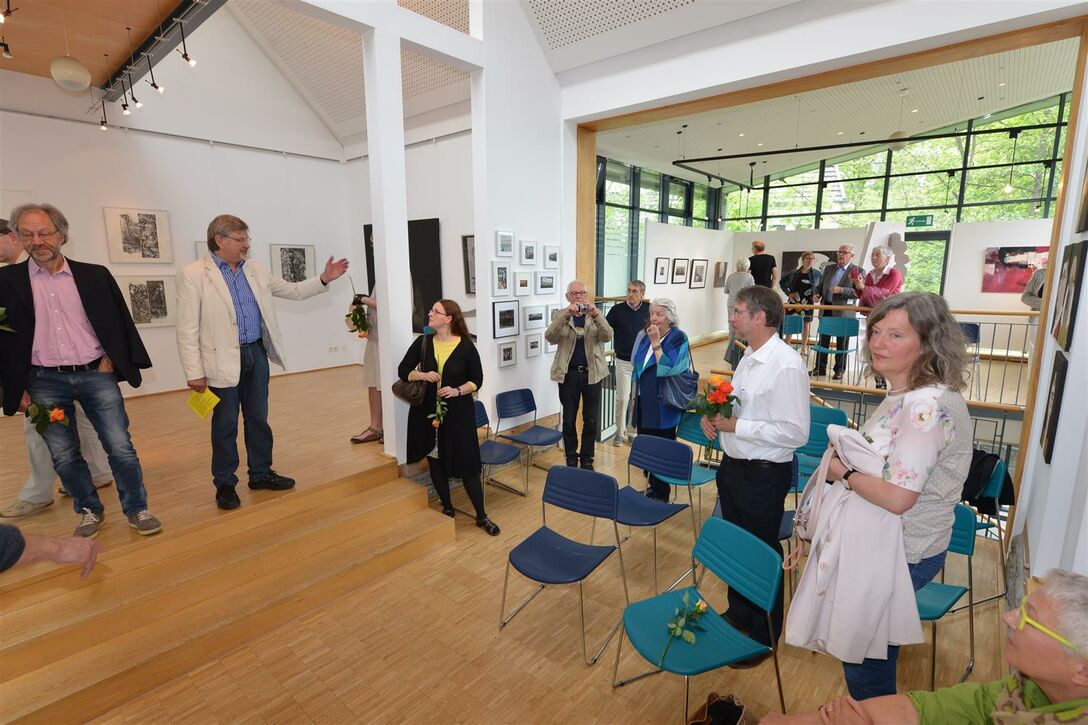on the other hand
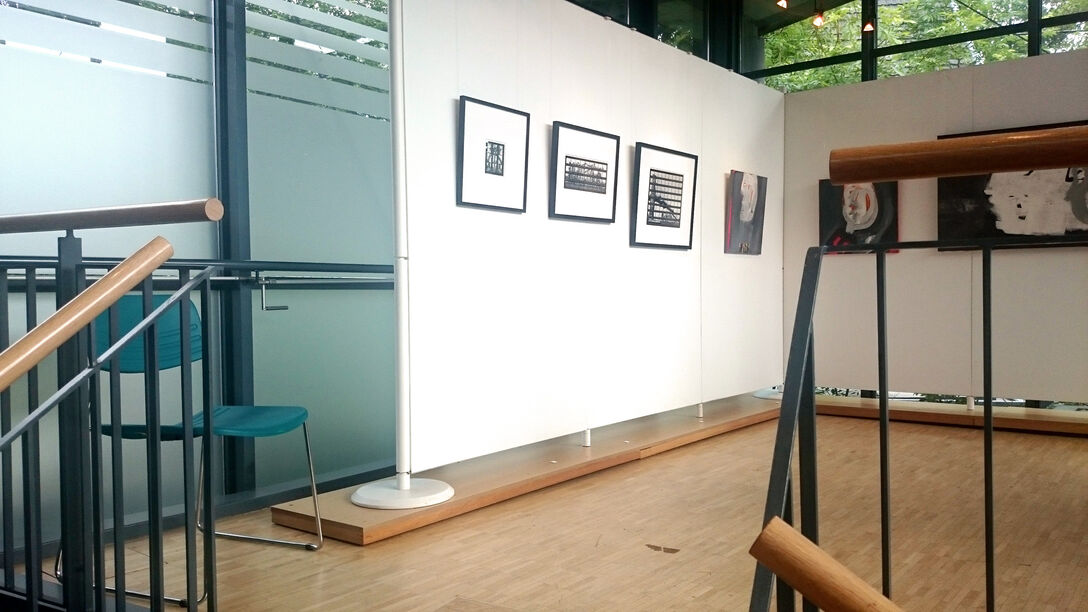
on the other hand

andererseits
May 22 - June 12, 2016
Kunstverein Nümbrecht, Germany
Participating artists: Ingo Schultze-Schnabl, Michael G. Müller, Silke Krah, Bruno Obermann, Thomas Kellner, Günther Hähner, Olaf neopan Schwanke, Stephanie Süßenbach, Helmut Geiss, Kai-Uwe Körner, Kurt Wiesner, Kristian Kosch, Dago Koblenzer, Stella Kown-Mockenhaupt.
On the other Hand
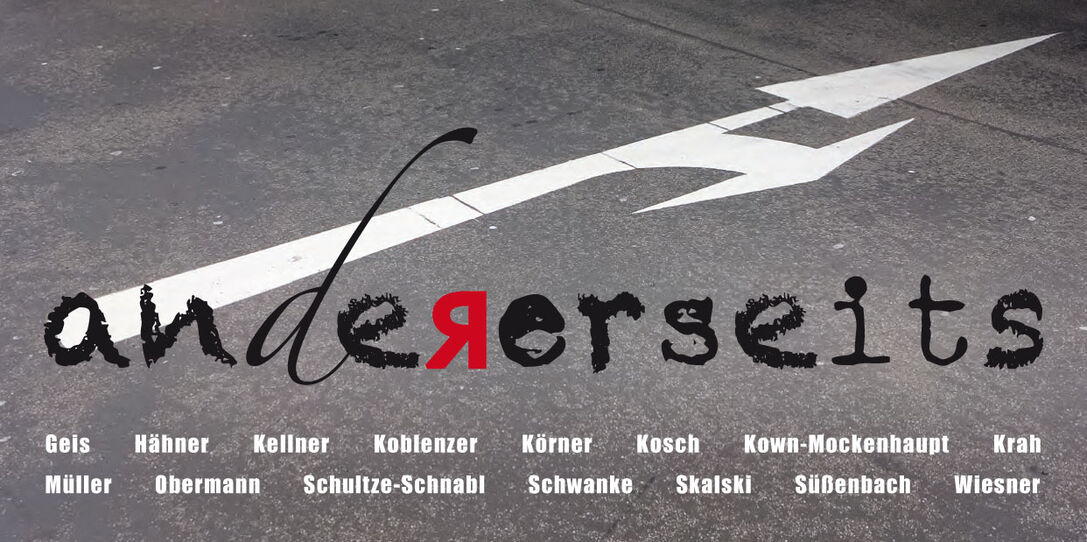
„All of these formal, compositional, reminiscent and visionary aspects explain Thomas Kellner's oevre up to now as an exciting and important contribution to contemporary photography.” Zehnder, Professor Frank Günter, PhD, Farbwelt 135-36, Kreis Düren, 2010, Düren, page 46
On the other Hand
on the other hand - ASK in Dialogue is the title of the exhibition currently being staged by the ASK, the Siegerland Artists' Association, in Nümbrecht, on the other side of the mountains, so to speak. From May 22 to June 12, 2016, 15 members are exhibiting current works at Haus der Kunst, the exhibition venue of the local art association. The play on words on the one hand - and on the other - has resulted in an exciting and varied collection of artworks, most of which have been created specifically for a particular theme. Birgit Ludwig-Weber, the first chairwoman, took up the long-standing contact and invited the group to a joint exhibition at the Kunstverein Nümbrecht.
The group includes Helmut Geis, Günter Hähner, Thomas Kellner, Dago Koblenzer, Kai-Uwe Körner, Kristian Kosch, Stella Kown-Mockenhaupt, Michael G. Müller, Bruno Obermann, Ingo Schultze-Schnabl, Olaf Neopan Schwanke, Stephanie Süßenbach and Kurt Wiesner with paintings, sculptures, photography and mixed media in a wide variety of formats.
The Kunstverein Nümbrecht cordially invites you to the opening of the exhibition on Sunday, May 22, 2016, at 11:30 am, at the "Haus der Kunst", Jakob-Engels-Straße 2, (Tel. 02293-6733). Art historian Kirsten Schwarz will provide an expert introduction, while Tim Müller will provide the musical backdrop with his guitar and loop box. The exhibition ends on Sunday, June 12, 2016 and will be rounded off with an artist talk with the participants at 4 pm.
The opening hours of the exhibition are Wednesdays to Fridays 16:00 to 18:00, Saturdays and Sundays 15:00 to 18:00. Admission to the events is free.
Thank you
Thank you to Arbeitsgemeinschaft Siegerländer Künstler and Kunstverein Nümbrecht for organizing this group exhibition in Nümbrecht
Black & White in the exhibition On the other HAnd
With "Black & White", Thomas Kellner refers to his origins as an artist and the origins of photography itself - black and white photography. Anyone familiar with Kellner's work knows that the majority of his published photographs are known for their intense interplay of light and color. This was not always the case, as Kellner has a black and white past.
At a time when many artists are turning back to black and white photography, Thomas Kellner is also looking back to his roots ten years later. The previously little published works in black and white reflect the beginnings of Kellner's career, when he finally found his unique, multi-perspective and deconstructivist visual language in 1997: the composite image either as multiple exposures on a negative (1993-1998) or as a sequential montage on a contact sheet of roll and 35mm film.
From an initial sketch of the Eiffel Tower as a homage to Robert Delaunay and Orphism in Paris, Kellner began to turn to architecture and increasingly complex compositions. He created timeless images in a newly formulated language based on Cubism. In his early black and white photographs, Kellner concentrated on the structure itself. The relationship between object and pictorial form is at the center of observation. Photographs from San Francisco, New York City and Chicago are made accessible to the public for the first time in "Thomas Kellner - Black & White".
Kirsten Schwarz M.A. gave the opening speech to On the Other Hand
Visiting a group exhibition differs significantly from visiting a solo exhibition. The reasons for visiting a group exhibition are, for example, to gain an overview of the different approaches to a theme, the tendencies, techniques and motifs of the artists. Held together only by a common title, one finds different approaches that refer to the theme in obvious, mystical, simple or complex ways. A decisive intention for me is the anticipation of the moment of surprise. You discover new works that fascinate, trigger an aha effect, touch you or make you smile. All in all, provided you come to get involved, you will find a wide variety of works that promise a satisfying art experience.
This is once again the case here: 15 artists from the Siegerland Artists' Working Group, which sees itself as non-programmatically oriented, are showing both new and older works, which can, however, always be related to the given theme. The artists see themselves as working individually and at the same time being prepared to engage in dialog with colleagues, which they all find enriching.
'On the other hand' is the theme of this exhibition. This is part of a well-known expression of weighing up: on the one hand - on the other. Important for the culture of discussion, for objective argumentation and for working through different aspects of a problem, but also for discussing contradictions within a situation. In other words, a concept of reflection. Artists also make use of different interpretations of the term, some implying the counterpart, some only looking at the 'other side'.
Bruno Obermann, for example, shows us mixed media heads in profile that dominate the pictures. With coarse brushstrokes, he undermines the obligatory attention to detail of portrait painting and yet shows individual physiognomies. The reduction does not lead to arbitrariness, but to concentration. His subjects are often sensitivities, states of mind that are difficult to paint, but which find their expression in an expressive manner, applied in many glazed layers.
Dago Koblenzer is the only exhibiting sculptor. Here the theme is worked out vividly, in the truest sense of the word. The forms cut from a hard foam cuboid are reused within the sculpture, placed elsewhere the forms proliferate into the space, at the same time we recognize their place of origin as a blank space. on the one hand - on the other hand is thus interpreted as a negative and positive form.
Ingo Schultze-Schnabl shows us new works from a dream world of cold-warm contrasts and floating forms. One immediately associates an unknown animal and plant world that passes beneath us. Swaying seaweed, slender fish bodies, South Sea colors. None of this is tangible, but the cut-outs on the panels, without beginning or end, allow us to imagine a world of our own.
For the exhibition, Thomas Kellner chose b/w photographs from the early days of his artistic career. His unmistakable style was already mature at that time, but the dissection and fragmentation of immobile objects into dancing arrangements of forms appears more abstract in the monochrome tonality than the later works in color. On the one hand, the solidity of the buildings - on the other, their completely unaggressive dismemberment and reassembly with the aim of achieving lightness with the help of an unconventional formal language.
Kristian Kosch reduces his contribution to a large-format painting. However, it fascinates with the strange aura it radiates. A girl, absorbed in looking at the glaringly bright display of her smartphone. This is the only source of light in the room and illuminates the girl's serious and absorbed-looking face in a strangely cold light from below. The composition is strongly reminiscent of Baroque chiascura painting and lends the scene a dramatic and quasi-religious feel. Instead of the agony of the saints or the face of Jesus, the light now focuses on the appropriation of human beings by modern communication technology.
Olaf N. Schwanke addresses a similar theme in his ink drawings. He, too, is concerned with a critical examination of the new media. However, he wants to draw attention to the aspect of self-staging, which plays a major role on the Internet. He calls the drawings 'chattering boys 1 + 2', which he calls 'ironic-erotic'. Two people beyond all common ideals of beauty, damaged, neglected bodies that reinvent and stage themselves for their appearance on the Internet and social media. A threatening development that, with the rapid pace of technological development, makes manipulation less and less transparent. A new self - at least externally - is possible, which in Schwanke's drawings literally obscures what he calls the other person's view of the entire personality.
Silke Krah likes to play with the moment of irritation. Her examination of seemingly outdated military customs and manifestations such as formations, parades and marches makes a mockery of this world. By processing found photographs with the simple analog means of overpainting, she makes the participants, who always appear serious and determined, appear harmlessly exposed. She intervenes in the details, but does so so effectively that the menace of the martial appearance suddenly appears grotesque.
Stella Known-Mockenhaupt's ink painting represents a calming influence in the series of exhibited works. Shades of gray, applied in calm sweeps and many bright, harmonious areas that arise when nothing has been painted. Careful placement of the areas is an important aspect of ink painting; it is not forgiving of mistakes. As a master of the technique, the artist knows where to place color and where not to in order to imagine a landscape as a silhouette or a distant idea. Pictures made of something and a lot of nothing, which makes associations possible in the first place.
Kurt Wiesner has devoted himself entirely to printing techniques. His experimentation with various types of relief and intaglio printing repeatedly leads to new, abstract shapes and forms. In the pair of pictures 'Werden und Vergehen' (Becoming and Passing Away), he deals with the abstract design of the opposing elements of fire and water. Color associations are used within a curved surface, each printed in mirror image.
A round shape, symbolizing air and light, nestles into each of these. Dynamic stripes connect the shapes and superimpose them at the same time. The play with the elements and contrasts of life is realized here with the means of the woodcut.
Günther Hähner probably presents the most color-intensive pictures here. Acrylic paintings whose titles and motifs only emerge in the process of painting. He works towards a theme. Areas of color applied in layers complement each other and give the work a direction. Division and structure give the pictures stability. This is followed by processing, in which surfaces are roughened or scratched off and fine line constructions are created that connect areas of the picture with one another. The artist creates traces and islands of color from strong contrasts. Pictures such as 'Stadtkern' are meant to be deciphered when viewed.
Kai-Uwe Körner sets a color accent. In addition to his small-format photo collages, a large-format red attracts the viewer. Appearing monochrome from a distance, the variety of shades is only revealed close up. Dots, layers, overlays, gradients. One loses oneself in contemplation, the red casts a spell. On the one hand monochrome - on the other hand a complex play of colors.
Stephanie Süssenbach wants to hold up a mirror to us with her animal portraits. Are they people with animal features or rather the other way around? The blending and reciprocal condition of identical facial features is a frequent theme in art and literature. How much of the other, the animal is in us? The caricature-like realization is not malicious, but illuminating. Evolution and adaptation are presented here with a wink.
Silke Skalski, photographer, shows the world from a new perspective. Her relatively small-format landscapes invite you to take a closer look. As part of an experiment, she has turned photography on its head. To create a panoramic image, the camera is panned from left to right according to the direction of reading. It recognizes the subject spread out in front of us and reproduces it. But what happens if you impose a new perspective on the camera? From bottom to top, for example, slowly raising the camera to the sky. What does it show now? With great effort and the appearance of mysterious doubling and wiping effects, the artist forces a new perspective on the camera - and it works!
Michael Müller's completely new mixed media works created for the exhibition fascinate with their elaborate and multi-layered design. He composes his works with the help of numerous found objects from the photographic and material realm. Here, historical photographs applied to slate and fragments worked with wax show a view of the other side of society, of poverty and decay. Child labor is thankfully forbidden in our part of the world. This was not always the case, as the pictures of working children reveal, emerging ghostly from the dark background of the slate. Material attributes of their activities have been added, bridging the gap between the past and the tangible present.
Last but not least, the washed drawings by Helmut Geis are quite vague. Floating forms, traces of movement, networks of lines without a center emerge before our eyes. In the search for concrete forms, the eye and brain play with associations and yet lose themselves in the confusing, interwoven signs. Helmut Geis has nothing concrete in mind when he draws. Rather, his interest in leaving graphic traces is a spiritual one. While listening intensely to music, he unconsciously lets the ink pen run over the prepared paper. A painterly ecriture automatique, as the surrealists called meditative, unconscious writing. Realistic and visionary sequences are created in this way and are later combined in pairs by the artist. In the best case, as Geis describes it, he enters into a creative flow, the result of which is always new and surprising.
I hope you enjoy looking at the diverse works and let yourself be surprised!
Der Besuch einer Gruppenausstellung unterscheidet sich wesentlich vom Besuch einer Einzelausstellung. Die Gründe, eine Gruppenausstellung zu besuchen, sind z.B. der Erwerb eines Überblicks über die unterschiedliche Gestaltung eines Themas, über Tendenzen, Techniken und Motive der Künstler. Zusammengehalten nur durch einen gemeinsamen Titel findet man unterschiedliche Herangehensweisen, die offensichtlich, mystisch, einfach oder komplex auf das Thema Bezug nehmen. Eine entscheidende Intention ist für mich die Vorfreude auf den Überraschungsmoment. Man entdeckt neue Werke, die faszinieren, einen Aha-Effekt auslösen, berühren oder zum Lächeln bringen. Insgesamt also, vorausgesetzt man kommt um sich einzulassen, findet man verschiedenste Werke vor, die ein befriedigendes Kunsterlebnis versprechen.
Dies ist auch hier wieder der Fall: 15 Künstler der Arbeitsgemeinschaft Siegerländer Künstler, welche sich als nicht programmatisch orientiert versteht, zeigen neue wie ältere Arbeiten, die sich jedoch stets auf das vorgegebene Thema beziehen lassen. Die Künstler verstehen sich als individuell arbeitend und zugleich zum Dialog mit Kollegen bereit, den sie alle als bereichernd empfinden.
‚andererseits‘ ist das Motiv dieser Ausstellung. Hierbei handelt es sich um einen Teil eines bekannten Ausdrucks des Abwägens: einerseits - andererseits. Wichtig für die Diskussionskultur, für sachliches Argumentieren und zur Aufarbeitung verschiedener Aspekte eines Problems, aber auch, um Gegensätzlichkeiten innerhalb einer Sachlage zu erörtern. Ein Begriff der Reflexion also. Auch die Künstler bedienen sich der verschiedenen Auslegungen des Begriffs, manche implizieren das Pendant, manche betrachten nur die ‚andere Seite‘.
Bruno Obermann etwa zeigt uns in Mischtechnik entstandene, die Bilder dominierende Köpfe im Profil. Mit grobem Pinselstrich unterläuft er die obligatorische Detailgenauigkeit der Porträtmalerei und zeigt doch eigene Physiognomien. Die Reduktion führt nicht zu Beliebigkeit, sonder zur Konzentration. Befindlichkeiten sind oft sein Thema, malerisch schwierig umzusetzende Zustände, die in vielen lasierenden Schichten aufgetragen doch ihren Ausdruck in einer expressiven Manier finden.
Dago Koblenzer ist der einzige ausstellende Bildhauer. Hier wird das Thema anschaulich, im wahrsten Sinne, herausgearbeitet. Die aus einem Hartschaumquader geschnittenen Formen werden innerhalb der Plastik weiterverwendet, an anderer Stelle angebracht wuchern die Formen in den Raum, zugleich erkennen wir ihren Ursprungsort als Leerstelle. einerseits-andereseits wird so interpretiert als Negativ -und Positivform.
Ingo Schultze-Schnabl zeigt uns neue Arbeiten aus einer Traumwelt aus kalt-warm-Kontrasten und schwebenden Formen. Man assoziert sofort eine unbekannte Tier- und Pflanzenwelt, die unter uns vorbeizieht. Wiegendes Seegras, schlanke Fischkörper, Südseefarben. Nichts davon ist greifbar, doch die Ausschnitte auf den Tafeln, ohne Anfang und Ende, lassen uns eine eigene Welt imaginieren.
Thomas Kellner wählte für die Ausstellung s/w-Fotografien aus den Anfängen seines künstlerischen Schaffens. Sein unverwechselbarer Stil war damals bereits ausgereift, doch die Zerlegung und Zerteilung von unbeweglichen Objekten zu tanzenden Formanordnungen wirkt in der monochromen Tonigkeit abstrakter als die späteren Arbeiten in Farbe. Einerseits die Solidität der Bauwerke - andererseits deren völlig unagressiv daherkommende Zerteilung und Neu-Zusammenfügung mit dem Ziel, Leichtigkeit mithilfe einer unkonventionellen Formensprache zu erlangen.
Kristian Kosch reduziert seinen Beitrag auf ein großformatiges Gemälde. Dieses jedoch fasziniert durch die eigenartige Aura, die es ausstrahlt. Ein Mädchen, versunken im Blick auf das gleißend helle Display ihres Smartphones. Dieses stellt die einzige Lichtquelle im Raum dar und beleuchtet das ernst und versunken wirkende Gesicht des Mädchens in eigenartig kaltem Licht von unten. Die Komposition erinnert stark an die chiascura-Malerei des Barock und verleiht der Szene eine dramatische und quasi-religiöse Anmutung. Statt der Qualen der Heiligen oder des Antlitzes Jesu fokussiert das Licht jetzt die Vereinnahmung des Menschen durch die moderne Kommunikationstechnik.
Einer ähnlichen Thematik widmet sich Olaf N. Schwanke in seinen Tuschezeichnungen. Auch ihm geht es um eine kritische Auseinandersetzung mit den neuen Medien. Er möchte jedoch auf den Aspekt der Selbstinszenierung hinweisen, der im Netz eine große Rolle spielt.’ Plapperjungs 1 + 2’ nennt er die Zeichnungen, die er ‚ironisch-erotisch‘ nennt. Zwei Personen jenseits aller gängigen Schönheitsideale, beschädigte, vernachlässigte Körper, die sich für den Auftritt im Netz und den sozialen Medien neu erfinden und inszenieren. Eine bedrohliche Entwicklung, die mit der rasanten technischen Entwicklung immer weniger durchschaubare Manipulationen ermöglicht. Ein neues Ich - zumindest äusserlich - ist möglich, welches in Schwankes Zeichnungen buchstäblich den Blick, wie er es nennt, des Anderen auf die gesamte Persönlichkeit verstellt.
Silke Krah mag das Spiel mit dem Moment der Irritation. Ihre Auseinandersetzung mit überholt wirkenden militärischen Bräuchen und Erscheinungsformen wie Formationen, Paraden und Aufmärschen zieht diese Welt ins Lächerliche. Durch die Bearbeitung vorgefundener Fotografien mit dem einfachen analogen Mittel der Übermalung lässt sie die immer ernst und entschlossen wirkenden Beteiligten harmlos enttarnt erscheinen. Sie interveniert im Detail, doch dies so wirkungsvoll, dass das Bedrohliche des martialischen Auftretens plötzlich grotesk erscheint.
Stella Known-Mockenhaupts Tuschemalerei stellt einen Ruhepol in der Reihe der ausgestellten Werke dar. Grautöne, in ruhigen Schwüngen aufgetragen und viele helle harmonische Flächen, die entstehen, wenn nichts gemalt wurde. Achtsamkeit im Setzen der Flächen ist ein wichtiger Aspekt in der Tuschemalerei, Fehler verzeiht sie nicht. Als Meisterin der Technik weiss die Künstlerin, wo Farbe gesetzt werden muss und wo nicht, um eine Landschaft als Schattenriss oder ferne Ahnung zu imaginieren. Bilder aus Etwas und viel Nichts, das Assoziationen erst ermöglicht.
Kurt Wiesner hat sich ganz der Drucktechnik verschrieben. Sein Experimentieren mit verschiedenen Arten des Hoch-wie Tiefdrucks führt immer wieder zu neuen, abstrakten Gebilden und Formen. In dem Bilderpaar ‚Werden und Vergehen‘ beschäftigte er sich mit der abstrahierten Gestaltung der gegensätzlichen Elemente Feuer und Wasser. Farbassoziationen werden benutzt innerhalb einer geschwungenen Fläche, die jeweils spiegelbildlich gedruckt wurde.
In diese schmiegt sich je eine runde Form, die Luft und Licht symbolisiert. Dynamische Streifen verbinden die Formen und überlagern sie zugleich. Das Spiel mit den Elementen und Gegensätzen des Lebens wird hier mit den Mitteln des Holzschnitts umgesetzt.
Günther Hähner präsentiert hier wohl die farbintensivsten Bilder. Acrylgemälde, deren Titel und Motiv erst im Prozess des Malens entstehen. Er arbeitet auf ein Thema zu. In Schichten aufgetragene Farbflächen ergänzen sich und geben dem Werk eine Richtung. Einteilung und Struktur geben den Bildern Halt. Anschließend erfolgt die Bearbeitung, bei der Flächen aufgeraut oder abgekratzt werden und feine Linienkonstrukte entstehen, die Bereiche des Bildes miteinander verbinden. Der Künstler setzt Spuren und Farbinseln aus starken Kontrasten. Bilder wie ‚Stadtkern‘ sollen in der Betrachtung entziffert werden.
Kai-Uwe Körner setzt einen Farbakzent. Neben seinen kleinformatigen Fotocollagen zieht ein großformatiges Rot den Betrachter an. In der Distanz monochrom wirkend, enthüllt sich die Vielfalt der Abstufungen erst in der Nahsicht. Tupfen, Schichten, Überlagerungen, Verläufe. Man verliert sich in der Betrachtung, das Rot zieht in den Bann. Bewegung entsteht. einerseits monochrom - andererseits komplexes Farbspiel.
Stephanie Süssenbach will uns mit ihren tierischen Porträts den Spiegel vorhalten. Sind es Menschen mit tierischen Zügen oder eher umgekehrt? Die Vermischung und gegenseitige Bedingung identischer Gesichtszüge sind durchaus öfter Thema in Kunst und Literatur. Wieviel des anderen, Animalischen steckt in uns? Die karikaturhafte Umsetzung gerät nicht boshaft, sondern erhellend. Evolution und Anpassung werden hier augenzwinkernd vorgeführt.
Silke Skalski, Fotografin, zeigt die Welt aus einem neuen Blickwinkel. Ihre relativ kleinformatig aufgezogenen Landschaften laden zu genauer Betrachtung ein. Sie hat innerhalb eines Experiments die Fotografie auf den Kopf gestellt. Um ein Panoramabild zu erstellen, schwenkt man die Kamera von links nach rechts entsprechend der Leserichtung. Sie erkennt dabei das vor uns ausgebreitete Motiv und bildet es ab. Was aber passiert, wenn man der Kamera eine neue Perspektive aufdrängt? Von unten nach oben etwa, die Kamera langsam zum Himmel hebend. Was zeigt sie nun? Unter Mühen und dem Erscheinen mysteriöser Dopplungs- und Wischeffekte zwingt die Künstlerin der Kamera einen neuen Blickwinkel auf - und es funktioniert!
Die ganz neuen für die Ausstellung entstandenen Mischtechniken Michael Müllers faszinieren durch die aufwendige und vielschichtige Gestaltung. Mitt Hilfe zahlreicher Fundstücke aus dem fotografischen wie dem stofflich-materiellen Bereich komponiert er seine Werke. Hier zeigen auf Schieferplatten aufgebrachte historische Fotografien und mit Wachs bearbeitete Fragmente einen Blick auf die andere Seite der Gesellschaft, auf Armut und Verfall. Kinderarbeit ist in unseren Breiten Gottseidank verboten. Dies war nicht immer so, wie die Bilder arbeitender Kinder offenbaren, die geisterhaft aus dem dunklen Hintergrund des Schiefers hervortreten. Stoffliche Attribute ihrer Tätigkeiten wurden hinzugefügt und schlagen den Bogen von der Vergangenheit in die konkret fassbare Gegenwart.
Last but not least kommen die lavierten Zeichnungen von Helmut Geis ganz unkonkret daher. Schwimmende Formen, Bewegungsspuren, Liniengeflechte ohne Zentrum entstehen vor unserem Auge. Auf der Suche nach konkreten Formen spielen Auge und Gehirn mit Assoziationen und verlieren sich doch in den verwirrenden, verwobenen Zeichen. Nichts Konkretes hat Helmut Geis beim Zeichnen im Sinn. Sein Interesse beim Hinterlassen grafischer Spuren ist vielmehr ein spirituelles. Während des intensiven Musikhörens lässt er unbewusst die Tuschfeder über das vorbereitete Papier fahren. Eine malerische ecriture automatique wie die Surrealisten das meditativ-unbewusste Schreiben nannten. Realistische wie visionäre Sequenzen entstehen so und werden später vom Künstler paarweise zusammengefasst. Im besten Falle, so beschreibt es Geis, kommt er in einen kreativen Flow, dessen Ergebnis immer neu und überraschend ist.
Ich wünsche Ihnen nun viel Vergnügen beim Betrachten der vielfältigen Arbeiten und lassen sie sich überraschen!
On the other Hand Exhibition
